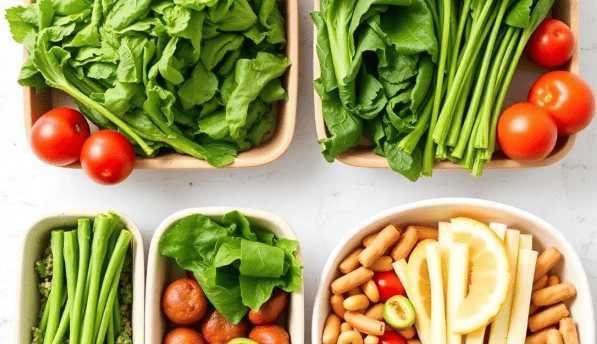How to Create a Balanced, Eco-Friendly Meal Plan
Blog post description.
♻️LIFESTYLE & SUSTAINABILITY


In recent years, the conversation around food and its impact on health and the environment has garnered significant attention. As people become increasingly aware of the benefits of a balanced diet and sustainable living, many are looking for practical ways to integrate eco-friendly practices into their daily lives. Creating a balanced, eco-friendly meal plan is an excellent way to ensure that your diet is nutritious and minimizes environmental harm. In this article, we will explore the fundamental principles of an eco-friendly meal plan, effective strategies for implementation, and examples to inspire your culinary creativity.
Understanding Balanced Nutrition
A balanced meal plan encompasses the ideal proportions of macronutrients: carbohydrates, proteins, and fats, as well as an array of vitamins and minerals. To achieve this balance, it's essential to include a variety of food groups:
Fruits and Vegetables: Rich in vitamins, minerals, and dietary fiber, fruits and vegetables should make up a significant portion of your meal plan. Aim for a colorful variety to ensure you're getting a wide range of nutrients.
Whole Grains: Whole grains, such as brown rice, quinoa, whole wheat pasta, and oats, offer essential carbohydrates and fiber. They are more nutrient-dense compared to their refined counterparts.
Proteins: Incorporate plant-based proteins such as beans, lentils, tofu, and nuts, as well as lean animal proteins if you choose to consume them. Protein is vital for muscle repair, immune function, and satiety.
Healthy Fats: Focus on sources of healthy fats, including avocados, nuts, seeds, and olive oil. These provide energy and essential fatty acids necessary for various bodily functions.
Choosing Eco-Friendly Ingredients
Environmental sustainability is a critical factor in the modern food landscape. When creating an eco-friendly meal plan, consider the following aspects:
1. Local and Seasonal Produce
Buying local and seasonal fruits and vegetables is one of the most effective ways to reduce your carbon footprint. Seasonal produce is typically fresher, tastes better, and has a lower environmental impact due to reduced transportation emissions. Visit local farmers’ markets or join a community-supported agriculture (CSA) program to access fresh, locally-grown ingredients.
2. Plant-Based Proteins
Shifting towards a more plant-based diet can significantly lower your meals' environmental impact. According to several studies, producing plant-based proteins generally requires fewer resources and emits less greenhouse gas compared to animal-based proteins. Strive to incorporate more legumes, legumes, nuts, and seeds into your meals while decreasing red and processed meat consumption.
3. Organic and Sustainable Choices
Purchasing organic food can enhance your eco-friendly efforts. Organic farming practices often utilize less synthetic pesticide and fertilizer, promoting healthier soil and reducing water pollution. Look for ethically sourced seafood and certified humane animal products to ensure more sustainable animal welfare practices.
4. Minimizing Food Waste
Incorporating strategies to minimize food waste in your meal plan is crucial. Plan meals that utilize ingredients across multiple dishes, store food properly to maintain freshness, and embrace leftovers creatively.
Practical Steps to Create Your Eco-Friendly Meal Plan
Now that you understand the principles of balanced nutrition and eco-friendly choices, let’s move on to how to create your meal plan.
Step 1: Set Your Goals
Before diving in, define your dietary goals. Consider aspects like weight management, specific health conditions, allergies, or preferences for plant-based or omnivorous diets. This clarity will guide your choices and ensure your meal plan aligns with your objectives.
Step 2: Plan Your Meals
Start by planning out your meals for the week. Use this framework:
Breakfast: Incorporate whole grains, dairy or plant-based alternatives, fruits, and healthy fats. Consider oatmeal topped with nuts and berries or a smoothie with spinach, banana, and nut butter.
Lunch: Aim to include a mix of proteins, grains, and vegetables. A grain bowl with quinoa, chickpeas, roasted vegetables, and avocado is a nutritious choice.
Dinner: Focus on a balance of protein, grains, and vegetables. A stir-fry featuring seasonal vegetables, tofu, and brown rice can be both satisfying and healthy.
Snacks: Keep snacks wholesome with options like fresh fruit, vegetables with hummus, or nuts.
Step 3: Create a Shopping List
Once you’ve finalized your meals, create a shopping list that includes your ingredients. Organize the list to flow with the supermarket layout, which can make your shopping trip more efficient. Prioritize local and seasonal produce, organic products, and bulk items to minimize packaging waste.
Step 4: Prepare in Batches
To make your meal plan more manageable, consider batch-preparing meals. Cook large portions of grains, beans, and roasted vegetables in advance. Store them in the fridge or freezer, making meal assembly quick and easy during the week.
Step 5: Stay Flexible
While planning is essential, remember that flexibility is key. If unexpected events arise, or you find yourself craving something different, be willing to adjust your meals. The goal is to maintain a healthy balance, not perfection.
Example of an Eco-Friendly Meal Plan
To give you a clearer picture, here’s a sample of an eco-friendly meal plan for a day:
Breakfast
Overnight oats with rolled oats, almond milk, chia seeds, and topped with sliced bananas and walnuts.
Lunch
A mixed salad with seasonal greens, cherry tomatoes, cucumbers, grilled chicken (or tofu), quinoa, and a vinaigrette dressing.
Snack
Sliced apple with almond butter.
Dinner
Stuffed bell peppers with a mixture of black beans, corn, brown rice, diced tomatoes, and spices, served with a side of steamed broccoli.
Dessert
A bowl of fresh berries or a small serving of dark chocolate.
Conclusion
Creating a balanced, eco-friendly meal plan is a meaningful step towards healthier living and sustainable eating. By understanding nutritional principles, making conscious ingredient choices, and planning your meals, you can take proactive measures to support both your health and the environment. As you embark on this journey, remember that each meal is an opportunity to reflect your values, support local economies, and contribute to a flourishing planet. With time and practice, designing a meal plan that honors both your body and the Earth can become not just feasible, but enjoyable.
